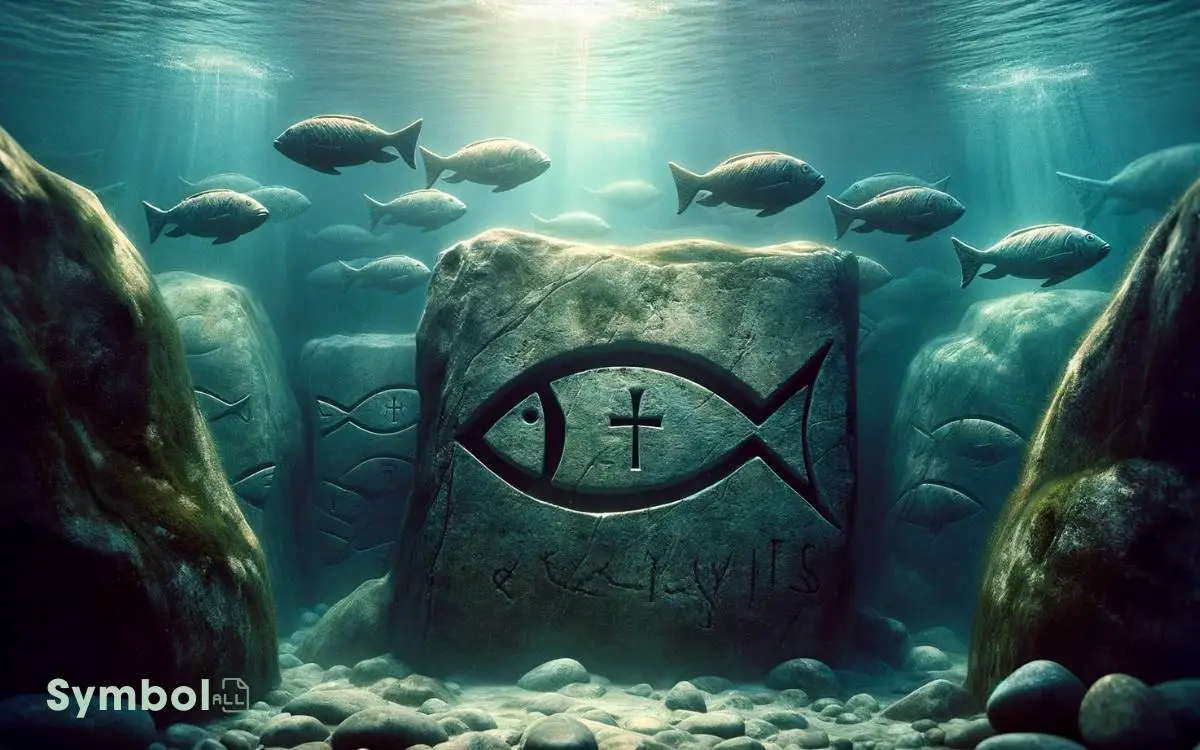Why Do Christians Use the Fish Symbol? A Sign Of Faith!
Christians use the fish symbol, originating in early Christian communities, as a sign of faith during the Roman Empire’s persecution. It was a discreet emblem, symbolizing resilience and unity among believers.
The Ichthys acronym, translating to “Jesus Christ, God’s Son, Savior,” conveys core Christian beliefs. This symbol served dual purposes: a secretive marker of faith and a means to foster identity and community.
Rooted in biblical stories, it embodies key themes like provision and resurrection. Its use in early Christian art as a subtle faith emblem and its modern adoption underscore its lasting relevance. Exploring further unveils its rich symbolism and history.

Key Takeaways
Historical Origins
The historical origins of the Christian fish symbol trace back to early Christian communities as a covert signifier of faith during periods of persecution.
You’ll find it fascinating that this symbol served as a discreet emblem among believers. Under the Roman Empire, Christians faced severe threats for their faith. You’ll find it fascinating that this symbol served as a discreet emblem among believers. Under the Roman Empire, Christians faced severe threats for their faith. To avoid detection, they often used coded imagery to identify one another, ensuring their safety while maintaining their fellowship. Interestingly, the symbol representing Mercury in astrology, often associated with communication and travel, shares a history of layered meaning, much like the Christian emblem that carried both practical and spiritual significance. These symbols remind us how visual representations can hold profound cultural and historical weight.
The fish symbol, therefore, offered a means to identify one another without drawing the attention of Roman authorities. Its simplicity and ubiquity in the natural world made it an ideal candidate for this purpose.
You’re looking at a practice born out of necessity, ingeniously allowing for the continuation and growth of the Christian faith under the radar of oppressive oversight.
This strategic use of an everyday symbol highlights the resilience and adaptability of early Christian communities in the face of adversity.
The Ichthys Acronym
Delving into the significance of the Ichthys acronym, you’ll discover that it’s not merely a symbol but encapsulates a profound declaration of faith within its letters.
Each character in the Greek word ΙΧΘΥΣ (Ichthys) stands for a word, forming the phrase ‘Jesus Christ, God’s Son, Savior.’
This acronym serves as a concise creed, articulating core Christian beliefs. It underscores Jesus’s identity as the Christ and affirms his divinity and role as the savior.
This linguistic construct not only reflects theological convictions but also fosters a sense of community among believers.
Persecution and Secret Codes
You must understand that early Christians faced significant persecution, compelling them to find covert ways to communicate.
The fish symbol emerged as a significant marker of their faith, serving both as a secret sign and a means of identifying fellow believers.
This method of secret communication highlights the ingenuity and resilience of the early Christian community in maintaining their practices and beliefs under threat.
Early Christian Persecution
During the early centuries of Christianity, believers faced intense persecution, compelling them to devise secret codes for safe communication. This need for discretion not only protected their gatherings but also safeguarded the transmission of their beliefs in hostile environments.
The development of these codes, including symbols like the fish, served as a testament to their resilience and ingenuity in preserving their faith.
| Aspect | Description |
|---|---|
| Purpose | Facilitate safe communication among Christians |
| Consequence | Fostered a sense of unity and identity among believers |
| Innovation | Led to the creation of symbols with deep religious meaning |
Analyzing this period reveals the profound impact of persecution on the evolution of Christian symbols and the importance of these symbols in fostering a cohesive, enduring community.
Fish Symbol Significance
Amidst the shadows of persecution, Christians adopted the fish symbol as a covert mark of faith and identification. This emblem served as a discreet signal amongst believers, allowing them to recognize each other without attracting the attention of Roman authorities.
The fish symbol’s significance lies not only in its simplicity but also in its profound theological implications. It encapsulates key Christian beliefs, notably the miracles and teachings of Jesus that involve fish, symbolizing abundance and faith.
Moreover, the Greek word for fish, ‘Ichthys,’ is an acronym for ‘Jesus Christ, God’s Son, Savior,’ embedding deep religious meaning into the symbol.
This layered significance made the fish emblem a powerful tool for silent solidarity and identity in a time of relentless persecution.
Secret Communication Methods
While the fish symbol represents a layer of Christian identity and belief, it also opens a window into the broader narrative of how early Christians employed secret communication methods to navigate through periods of intense persecution.
You’ll find that beneath the surface, this symbol served as a covert signifier, enabling believers to identify each other without arousing the suspicion of Roman authorities. This strategy wasn’t merely about maintaining their faith in secret; it was a vital survival mechanism.
It allowed for the discreet organization of gatherings and the safe sharing of texts, which were critical for the preservation and dissemination of their teachings.
Analyzing these clandestine practices reveals not just the resilience of early Christians, but also the profound role symbolic language has played in human history as a tool for preserving identity and knowledge under threat.
Biblical References
You’ll find that the fish symbol’s roots in Christianity are deeply intertwined with biblical narratives.
The miracles of Jesus feeding the multitude and Jonah’s three-day ordeal in the belly of a great fish exemplify its significance.
These stories underscore the fish’s symbolic representation of faith, provision, and resurrection within Christian theology.
Early Christian Fish Significance
In analyzing the significance of the fish symbol in early Christianity, it’s crucial to explore its biblical references, which underscore its deep-rooted symbolism in Christian faith.
| Reference | Book | Significance |
|---|---|---|
| Matthew 4:19 | Matthew | Jesus calls disciples to become “fishers of men,” emphasizing evangelism. |
| Luke 5:1-11 | Luke | Miraculous catch of fish, symbolizing God’s provision and the gathering of believers. |
| John 21:1-14 | John | Post-resurrection appearance by the Sea of Tiberias, reinforcing faith and fellowship. |
| 1 Corinthians 15:39 | Corinthians | Differentiates flesh of humans and fishes, hinting at diversity in unity within Christianity. |
These references collectively reveal how the fish symbol not only represents Christian faith but also encapsulates key theological themes such as evangelism, divine providence, resurrection, and community.
Jesus Feeds the Multitude
Moving from the symbolic significance of fish in Christianity, let’s examine the accounts of Jesus feeding the multitude, which further underscore the theme of divine provision and community in the Christian faith.
In the Gospels, there are notable instances where Jesus miraculously feeds thousands with just a few loaves of bread and fish. These events aren’t merely about the physical nourishment of the crowd but also symbolize the spiritual sustenance Jesus provides.
Analyzing these miracles, scholars highlight the emphasis on Jesus’s compassion and his role as a provider, aligning with the fish symbol’s connotation of abundance and faith.
Moreover, these narratives reinforce the idea of community gathering, where the act of sharing a meal becomes a reflection of the early Christian communal practices and values.
Jonahs Three-Day Ordeal
Exploring Jonah’s three-day ordeal inside the belly of a great fish, as recounted in the Book of Jonah, reveals profound insights into themes of repentance, divine mercy, and human obedience.
| Theme | Implication |
|---|---|
| Repentance | Jonah’s confinement symbolizes a period of introspection and turning away from disobedience. |
| Divine Mercy | Despite Jonah’s initial defiance, the fish’s belly becomes a place of salvation rather than punishment, highlighting God’s compassion. |
| Human Obedience | Jonah’s eventual decision to follow God’s command post-release underscores the importance of aligning one’s actions with divine will. |
This narrative serves as a powerful allegory for the Christian journey, emphasizing the necessity of repentance, the hope found in divine mercy, and the transformative power of obedience.
Symbolic Meanings
Several layers of meaning are embedded within the Christian fish symbol, each representing key aspects of Christian faith and tradition. At its core, the fish symbolizes Jesus Christ and His followers.
The Greek word for fish, ‘Ichthys,’ forms an acronym for ‘Jesus Christ, God’s Son, Savior,’ encapsulating the essence of Christian belief.
This symbol also reflects the early Christians’ practice of baptism, symbolically associating believers with water, much like fish. Furthermore, the fish represents the miraculous feeding of the 5,000, a testament to Jesus’ provision and abundance.
Thus, the fish symbol serves as a multifaceted emblem, embodying the identity, beliefs, and historical roots of Christianity, offering believers a concise yet profound expression of their faith.
Early Christian Art
How did early Christians incorporate the fish symbol into their art, reflecting their beliefs and clandestine practices?
You’ll find that during times of persecution, early Christians adopted the fish symbol as a discreet emblem of their faith.
This symbol, known as the Ichthys, was ingeniously woven into their art, serving both as a secret sign of recognition among believers and a profound expression of their religious convictions.
It adorned the walls of catacombs, pottery, and early Christian tombs, subtly signaling a safe haven for worshippers.
The fish symbol’s simplicity belied its profound significance, encapsulating key theological tenets such as Jesus’ role as the ‘fisher of men’ and the importance of baptism.
This strategic incorporation of the fish symbol exemplifies early Christians’ resilience and ingenuity in preserving and expressing their faith under the radar of Roman scrutiny.
Modern Adoption and Usage
Building on the historical roots of the fish symbol in early Christian art, its modern adoption and usage continue to reflect a deep-seated connection to Christian identity and values.
Today, you’ll see the fish symbol utilized in various aspects of Christian life, each serving a unique purpose:
- Personal Identification: Car decals and jewelry featuring the fish symbol serve as a marker of one’s faith, subtly signaling Christian belief to others.
- Evangelism Tools: The symbol is often used in literature and digital media as a means to engage in conversations about faith, serving as a non-verbal witness to Christian beliefs.
- Church Decor: Many churches incorporate the fish symbol into their architecture and interior design, underscoring the historical and spiritual significance of the symbol within the faith community.
These usages underscore the symbol’s enduring relevance in expressing and celebrating Christian faith.
Variations and Interpretations
The fish symbol, though universally recognized within Christianity, manifests in various forms, each carrying distinct interpretations and theological significance. You’ll find that the basic ichthys, a simple outline of two intersecting arcs, serves as the foundation.
However, variations exist, such as those incorporating a cross within or alongside the fish, symbolizing a deeper connection to Christ’s crucifixion and resurrection.
Another variation includes the Greek letters for ichthys, spelling out ‘Jesus Christ, God’s Son, Savior,’ and reinforcing the symbol’s early catechetical role.
Each variation not only enriches the symbol’s visual diversity but also deepens its theological resonance, offering believers multiple layers of meaning to explore and embrace.
These nuanced interpretations highlight the symbol’s adaptability and enduring relevance in expressing foundational Christian beliefs.
Personal and Communal Identity
When you explore the fish symbol’s origins, you uncover a rich tapestry of beliefs and values that have cemented its role in Christian identity.
This emblem not only signifies individual faith but also fosters a sense of unity among believers, transcending cultural and geographical boundaries.
It serves as a potent reminder of the shared convictions and communal spirit that define the Christian community.
Origins of Fish Symbol
In early Christianity, followers adopted the fish symbol as a discreet marker of personal and communal identity amidst widespread persecution. This choice wasn’t arbitrary but steeped in practicality and significance.
Here’s why:
- Secrecy: The fish symbol allowed Christians to identify each other without attracting the attention of Roman authorities. Its ubiquity in daily life made it inconspicuous, serving as a perfect covert sign.
- Accessibility: Easily drawn, the fish symbol required no artistic skill, making it accessible to all believers, irrespective of their social status or education.
- Symbolic Resonance: The Greek word for fish, ‘Ichthys,’ was an acronym for ‘Jesus Christ, Son of God, Savior,’ embedding profound theological significance into a simple image.
These elements combined to solidify the fish as a powerful emblem of early Christian identity.
Signifying Beliefs and Values
Employing the fish symbol, early Christians communicated shared beliefs and values, cementing their personal and communal identity amidst a broader, often hostile, societal context.
This icon not only signified an adherence to Christian teachings but also subtly announced membership within a distinct group that espoused love, faith, and hope as central tenets.
By adopting this symbol, individuals didn’t merely express a personal faith; they also aligned themselves with a community that transcended local and cultural boundaries.
The fish symbol served as a non-verbal shorthand for a complex set of beliefs, effectively bridging diverse linguistic and geographic divides.
It encapsulated the essence of Christian doctrine in a simple, yet profound, manner, facilitating a sense of belonging and shared purpose among early followers.
Unity Among Believers
Building on the shared beliefs and values signified by the fish symbol, the unity among believers further solidified personal and communal identity within the early Christian community.
This unity wasn’t merely symbolic but manifested in various tangible ways that contributed to the strengthening of both individual faith and the collective Christian identity.
Here are three key aspects:
- Collective Worship Practices: Group gatherings for worship and prayer reinforced communal bonds.
- Mutual Support Systems: Sharing of resources among believers exemplified the practical application of their faith.
- Evangelistic Outreach: Unified efforts in spreading the Christian message underscored their shared commitment to their beliefs.
These elements, underpinned by the fish symbol, fostered a strong sense of belonging and identity among early Christians, highlighting the symbol’s significance not just as a marker of faith but as a catalyst for unity.
The Fish in Contemporary Culture
Today, the fish symbol swims through contemporary culture, serving as a multifaceted emblem for Christians worldwide.
Its presence on bumper stickers, jewelry, and digital media underscores its role as a badge of faith, signaling a connection to the Christian community. This adaptation showcases the symbol’s flexibility and enduring relevance.
You’ll find it used not only for religious identification but also as a tool for evangelism, silently communicating one’s beliefs in a pluralistic society.
Moreover, the fish symbol’s incorporation into contemporary art and literature emphasizes its cultural significance beyond mere religious identification. It acts as a bridge, linking ancient traditions with modern expressions of faith, thus enriching the cultural fabric.
Its persistent use underscores a collective desire for continuity and shared identity among Christians in an ever-changing world.
Conclusion
The fish symbol serves as a poignant emblem within Christianity, embodying both a rich historical legacy and a profound spiritual significance. Its journey from a clandestine marker to a ubiquitous symbol of faith underscores a narrative of resilience, adaptation, and unity.
As you delve deeper, you’ll find that this simple ichthys encapsulates a tapestry of beliefs, struggles, and hopes, challenging us to ponder its continued relevance and evolution in our ever-changing world.






